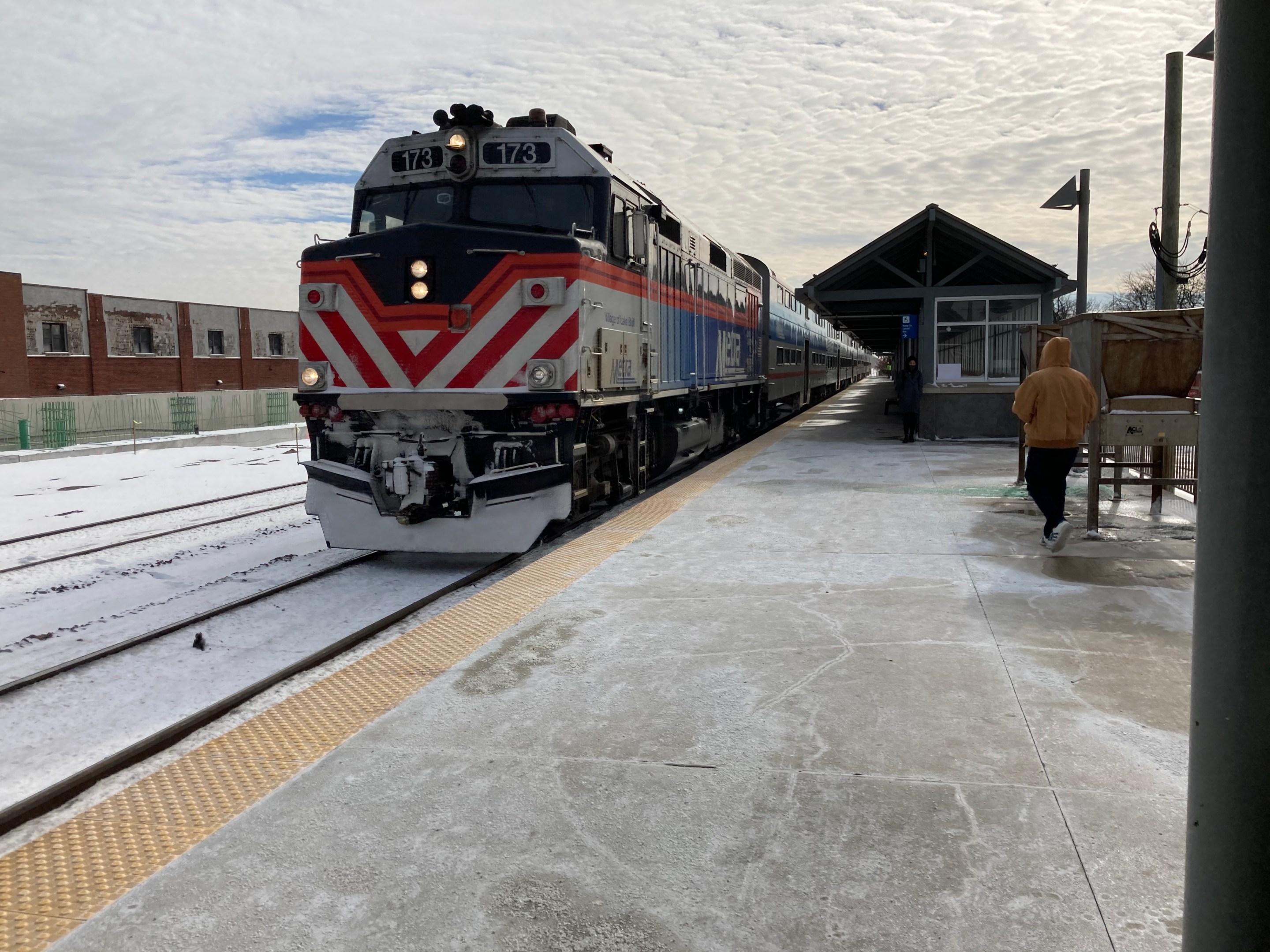At Metra's February 17 board meeting, head of strategic capital planning Lynnette Ciavarella warned the railroad's directors that during an unprecedented global pandemic it was hard to make any kind of comparisons about the railroad's ridership or make any predictions. But she tried anyway.
According to Metra's 2020 annual ridership report, ridership didn’t wind up plunging as badly as the transit agency initially feared, but neither did it rebound as much as was hoped. After ridership plummeted to a mere 10 percent of normal levels early in the pandemic, by the end of the year it had risen to 25 percent. But Ciavarella said her staff remains hopeful that the ridership will gradually return as more people get vaccinated, businesses bring more workers back and schools reopen.
The ridership numbers come with several caveats. With conductors and ticket agents not working during the spring, and Union Pacific railroad still not having conductors collect fares on the three lines it runs for Metra, the ridership figures aren’t quite as reliable as they usually are. The sheer size of the ridership drop, as well as the fact that Metra carried more transit-dependent riders than ever, made any kind of apples-to-apples comparisons difficult. That is why I pulled the proportions rather than trying to compare actual numbers.
Metra Ridership in 2020
Ciavarella said that while the first two months of 2020 suggested a “banner year” ahead, ridership plummeted in mid-March as Illinois' Stay at Home order went into effect. As some restrictions were lifted during the summer, ridership recovered to almost 30 percent of regular levels, but the numbers dropped again as COVID-19 positivity rates increased once more in October and new restrictions were put in place, such as bans on indoor restaurant and bar service.
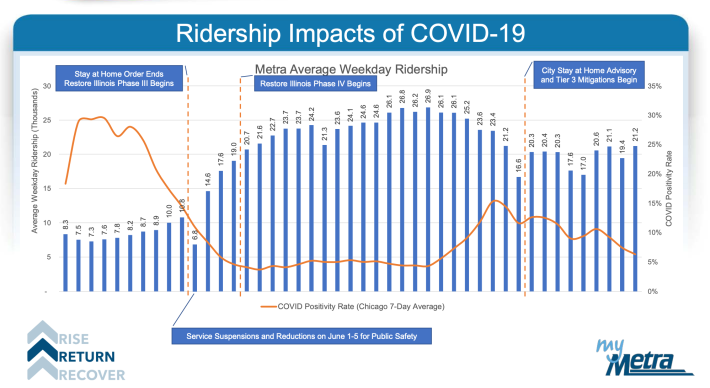
Back in the spring, the Metra Electric District and Rock Island District lines fared slightly better than the rest of the system, perhaps since they serve essential workers who live on the South Side and in the south suburbs. Since then, the BNSF, Union Pacific Northwest and Union Pacific North lines regained their usual top three spots, but the MED and RID still wound up getting a somewhat bigger portion of the riders than they usually do. The report estimates that from in 2016 to 2019 these two lines accounted for 10.3 percent and 10 percent, respectively, of Metra’s overall ridership. In 2020, those numbers were 10.9 percent and 10.5 percent.
2020 saw a larger portion of the riders taking Metra within Chicago city limits, and the number of “intermediate” trips that don’t start or end at the Loop increased as well. Again, this may be due commutes by essential workers making up a higher percentage of trips.
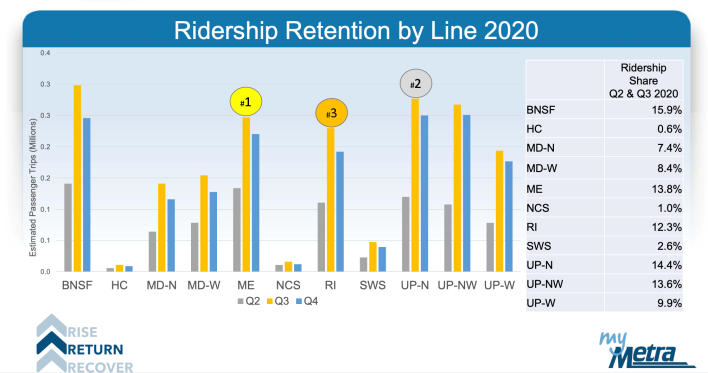
The report also touched on the pandemic's effect on cyclists. In October 2020, Metra relaxed its bike-on-train restrictions, allowing cyclists to bring bikes aboard during rush hours, even in the busiest direction, if there’s enough room. Metra carried 113,000 bicycles last year – a decrease of 37 percent compared to 2019, but still a substantial number.
Ciavarella said that 2020 highlighted how important Metra services are for those who don’t have the option of working from home. “As we looked at Metra ridership in 2020, Metra also retained a higher percentage of transit dependent [riders] and essential workers,” she said. “It is important to recognize that these trips are vital and that Metra played vital role in providing these particular trips.”
Ticket-Buying Trends
One might think that, with so many people working from home, the percentage of riders buying monthly passes would drop. But that percentage actually increased from 7.6 percent in 2019 to 9.8 percent in 2020. The percentage of riders buying 10-ride tickets also increased slightly from 13.50 percent in 2019 to 13.55 percent in 2020. The percentage of riders buying one-way tickets dropped from 71.30 percent in 2019 to 61.69 percent in 2020.
In April 2020, Metra piloted the $10 All-Day Pass, which functions like the Weekend Pass, in that it allows for unlimited rides in all fare zones, except that the All-Day Pass is only good for one day. The ticket proved popular enough that Metra is keeping it around until March 31, 2021. Riders purchased 305,931 passes in 2020, which accounted for 8.99 percent of all Metra ticket sales. “The $10 pass became extremely popular,” Ciavarella said, adding that it accounted for 31.7 percent of all October 2020 ticket sales.
In September 2020, Metra introduced the Ventra app exclusive Round Trip Plus, which works more like a monthly pass by providing unlimited trips within specific fare zones, except, again, for just one day. 11,965 of those tickets were sold by the end of the year, accounting for 0.35 percent of all ticket sales.
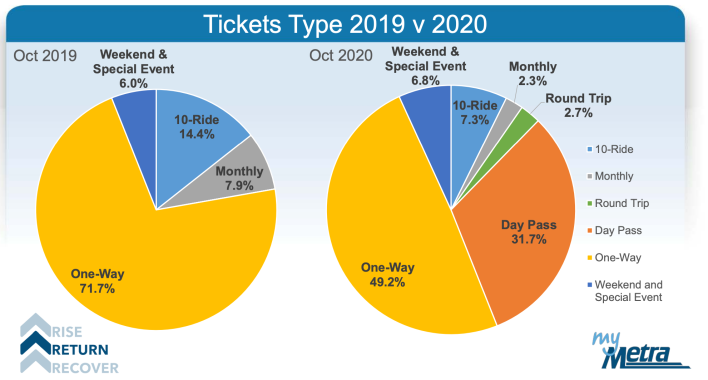
The report also showed a shift toward contactless ticketing – though not quite as much as one may expect. The percentage of riders who bought tickets using the Ventra app went up from 51.8 percent of all ticket purchases in 2019 to 56 percent of all ticket purchases in 2020. Meanwhile, the percentage of tickets purchase from conductors on the trains went down from 17.2 percent to in 2019 to 16.6 percent. The percentage of tickets purchased from ticket agents saw a more notable decrease, going from 24.1 percent to 20.1 percent. The percentage of riders who used vending machines dropped from 3 percent to 2.6 percent.
Ciavarella noted that, from March to August 2020, Metra offered free riders for medical workers, which resulted in 12,000 free trips.
Projections for the future
While Ciavarella said “the crystal ball is constantly moving,” Metra sees some hopeful signs that ridership will rebound, even if it’s not clear how quickly that will happen. She said that, according to the November 2020 RTA rider survey, “83 percent of pre-COVID Metra riders planned to ride as much as before when things retuned to the new normal.”
Ciavarella also pointed to the rise in home sales in suburban parts of the six-county region, especially further-flung DuPage, Kane, McHenry and Lake counties. “It is interesting, because they could be potential Metra riders in the future,” she said. “While sales have [recently] slowed, the home sales that already occurred could be a future source of Metra riders.”
Metra is also encouraged by the data coming from the Fair Transit South Cook Pilot, with reduced fares on the portions of MED and RID to bring them more at par with CTA buses and ‘L’ trains. She said that sales of January and February monthly passes on the two lines were higher than on the BNSF line. The passes cost $70 for fare zones A-B and $96.25 for fare zones A-C – less than the $105 CTA/Pace 30-Day Pass, to say nothing of Metra monthly passes for other lines for zones A-B ($123.25) and zones A-C ($159.50). “While the increase of monthly ticket is certainly a good sign, the plot is still in the early phases,” Ciavarella said.
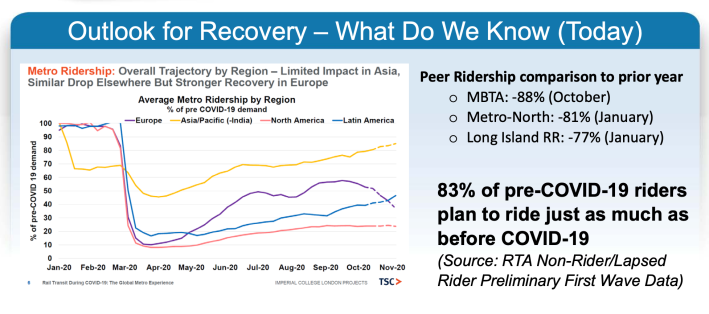
Metra plans to gradually increase the number of trains throughout 2021, even though the transit agency doesn’t expect to see significant increases in ridership until 2022, and ridership isn't expected to approach pre-pandemic levels until 2023. The tricky thing, Ciavarella explained, is that they have to do the increases ahead of the rising demand – after all, if riders are going to use Metra more, they need to know the options are available.
“With more vaccines on the horizon, and people getting vaccinated, with the outlook for the summer looking more positive, and more students going back to in-person learning, we are eager and interested to see how those things will work out,” she said.
